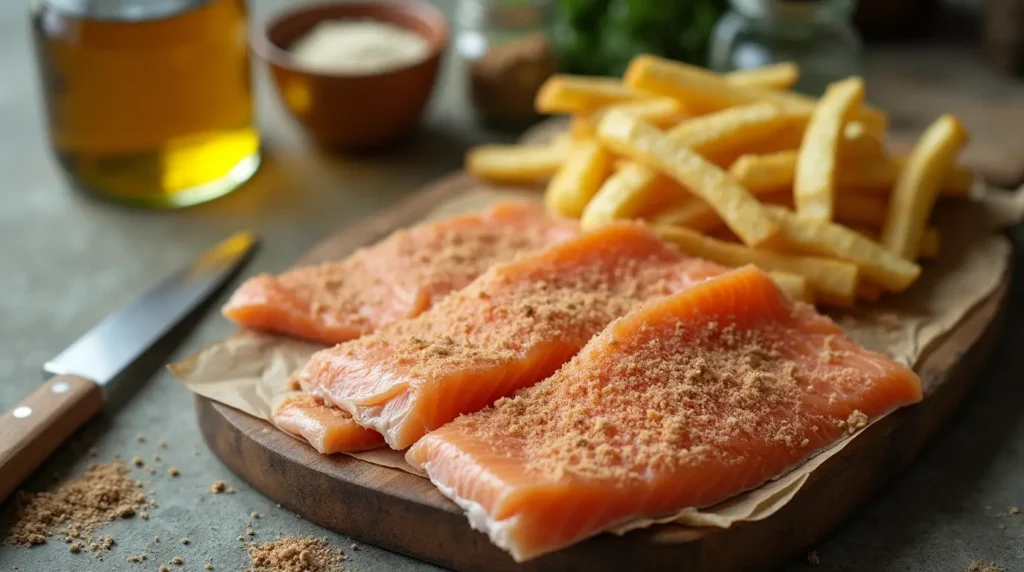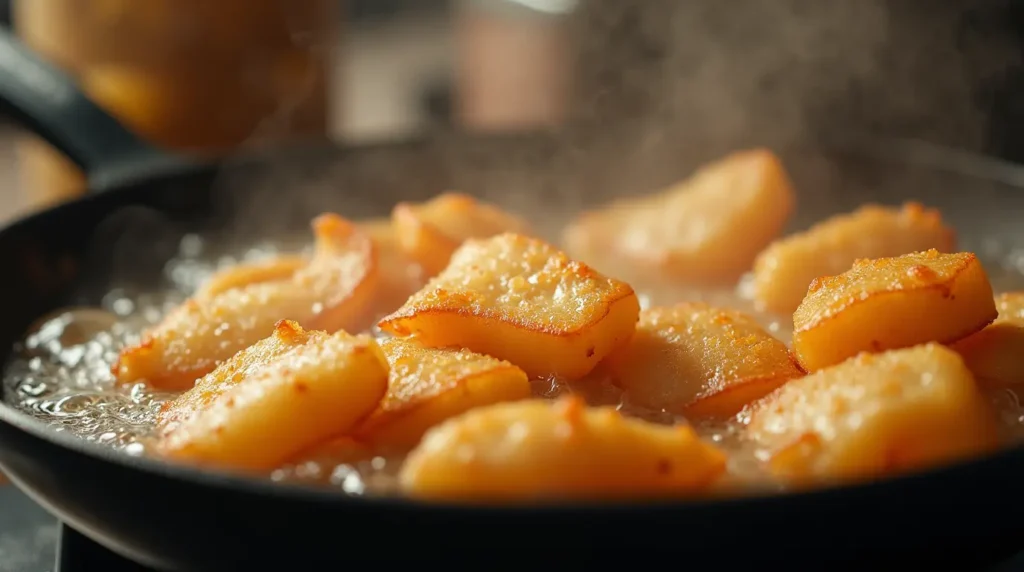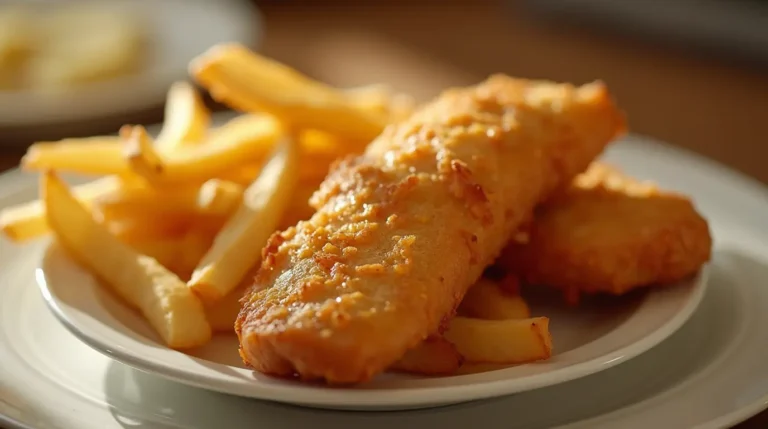Hello, food lovers! Are you craving the crispy, satisfying flavors of fish and chips, but looking for a lectin-free option? Today, we’re diving into a guide that will show you how to make perfectly crispy and delicious, lectin-free fish and chips at home. This isn’t just about omitting a few ingredients; it’s about using clever techniques and the right components to create a dish that’s both healthy and incredibly tasty. This guide will walk you through every step of creating this unique version of a classic meal. So, gather your ingredients, and let’s get started making this amazing lectin free fish and chips recipe!
Understanding Lectin Free Fish and Chips
Before we get to the recipe, let’s understand what exactly “lectin-free” means, and how that changes this classic dish. Traditional fish and chips often contain ingredients that are high in lectins, a type of protein that some people choose to avoid. Creating a lectin-free version is all about finding substitutes that do not contain these ingredients, while still keeping the flavour and textures that make this dish so great. It’s a thoughtful approach to making a classic comfort food that meets your specific dietary needs. This lectin free fish and chips recipe is a great way to enjoy a classic meal, without having to sacrifice your dietary needs or restrictions.
What are Lectins and Why Avoid Them?
Lectins are a type of protein that are found in many foods, such as grains, legumes, and certain vegetables. Some people choose to avoid them due to various dietary reasons, which may relate to digestion. While many foods that contain lectins are healthy and full of beneficial nutrients, some people choose to limit or avoid them. This is a personal choice, and one that is based on your own unique needs. This recipe is created to be suitable for people who have chosen to limit their lectin intake, and it will be a great way to still enjoy a delicious version of this amazing dish.
Adapting Traditional Fish and Chips for a Lectin Free Approach
Creating a lectin free fish and chips recipe involves replacing ingredients that are high in lectins, while maintaining the flavours and textures that we all love. This means swapping out traditional wheat flour for lectin-free alternatives, and using a careful selection of vegetables and seasonings. It’s not just about leaving things out; it’s about making smart substitutions, and building layers of flavour that will help to create a truly amazing outcome. The traditional methods have to be reconsidered, and we will need to adapt them to achieve the best outcome for this dish.
Gathering Your Ingredients: What You’ll Need
Okay, let’s get started. Before we begin, we need to make sure that we have all the ingredients required for our lectin free fish and chips recipe. Having everything measured and prepared will make the cooking process much smoother. Let’s see what you will need!
Choosing Lectin-Free Fish: Options for a Healthy Base
When choosing a fish for this recipe, you want to select a variety that is naturally lectin-free, and one that will hold up well during cooking. Good options include cod, haddock, or halibut, as these are all low in lectins, and have a mild flavour that will make them a great base for your dish. Be sure to choose a high quality and fresh fish, as this is an important step in creating the best lectin free fish and chips.
Lectin-Free Flour and Coating: Achieving a Crispy Texture
Traditional fish and chips use a batter that is made with wheat flour, which is high in lectins. Therefore, you need to find good substitutes, such as:
- Almond Flour or Coconut Flour: These are both good options for a lectin-free batter.
- Arrowroot Starch or Tapioca Starch: For a crispy and light texture.
- Baking Soda: This will also help you achieve a light and fluffy texture.
Using a combination of these different ingredients will result in a crisp, light and fluffy coating for your fish. Choosing the right coating is very important for achieving that crispy texture, so be sure to select what works best for your unique preferences. It is essential to choose a good coating for your lectin free fish recipe.
Lectin-Free Oil: Selecting the Right Oil for Frying
When choosing an oil, you also want to be careful to choose an option that is lectin-free, and also has a high smoking point. Avocado oil and coconut oil are great options for frying, as these are both low in lectins and they have high smoking points, making them ideal for frying fish and chips. Be sure to use enough oil, so that all of the pieces are submerged, and they all cook evenly. The choice of oil is a vital part of the process, so choose wisely, and select what works best for you.

Seasonings: Enhancing the Flavour While Keeping it Lectin Free
Finally, the last element is the selection of seasonings to enhance the flavor of your fish and chips:
- Salt and Pepper: These are classic seasonings, and should always be used!
- Garlic Powder and Onion Powder: To add depth and flavour.
- Paprika or Cayenne: For a touch of heat.
- Fresh Herbs: Like thyme or parsley for freshness.
These seasonings will allow you to add flavour to your lectin free fish and chips, without adding any unwanted lectins. The proper balance of seasonings, will really elevate your dish and make it a memorable experience!
Before we begin cooking, let’s make sure you have all of the ingredients ready for your lectin free fish and chips recipe, and all of their quantities are just right. Here is a complete list:
| Ingredients | Quantity |
|---|---|
| Lectin-Free Fish (Cod, Haddock, Halibut) | 1 pound (450 g) |
| Almond Flour or Coconut Flour | 1/2 cup |
| Arrowroot Starch or Tapioca Starch | 1/4 cup |
| Baking Soda | 1/2 teaspoon |
| Avocado Oil or Coconut Oil | For frying |
| Salt and Black Pepper | To taste |
| Garlic Powder and Onion Powder | 1/2 teaspoon each |
| Paprika or Cayenne (optional) | 1/4 teaspoon (or to taste) |
| Fresh Herbs (Optional) | To taste |
Step-by-Step: Making Your Lectin Free Fish and Chips
Now that we have all our ingredients prepared, it’s time to get cooking! This process is straightforward, and I’ll guide you through each step of this lectin free fish and chips recipe. We’re aiming for crispy, flavourful, and delicious results that are also safe for a lectin free diet!
Step 1: Preparing the Fish and Coating
First, cut the fish into appropriately sized strips, or smaller portions. Then, in a medium sized bowl, combine the flour or starches and baking soda, and any other spices you would like to use for the coating. This will create the coating for your fish, so be sure to mix the dry ingredients thoroughly. Preparing the coating mixture is essential for achieving that crispy texture that we are looking for, and is therefore a very important part of the process.
Step 2: Achieving the Perfect Fry for Your Lectin-Free Dish
Heat the oil in a deep frying pan or a pot to 350°F (175°C). Then, coat each piece of fish with the flour mixture, ensuring that it is evenly covered. Carefully place the coated fish into the hot oil, and fry until golden brown and crispy. You should only cook a few pieces at a time, to avoid overcrowding the pan, and lowering the temperature of the oil. Using a thermometer is very helpful to ensure the correct oil temperature. Proper frying of the fish is key for creating a crisp, golden and perfectly cooked outcome, and for making this fish and chips recipe a success.
Step 3: Serving and Enjoying Your Crispy Fish and Chips
Once cooked, remove the fish from the oil, and place it on a wire rack or paper towel lined plate, to drain any excess oil. Be sure to add salt and pepper to your liking while it is still warm. Serve your fish immediately with chips (use a lectin free version), and any other toppings or sauces that you like. Enjoy your freshly made lectin free fish and chips right away, while they are still at their best! This final step is where you will get to enjoy the outcome of all your hard work!
Now that you have completed your amazing fish and chips, let’s consider the estimated macronutrients per serving, to get a better idea of the nutritional profile of the dish.
| Macronutrient (per serving) | Amount (estimated) |
|---|---|
| Calories | 400-500 kcal |
| Protein | 25-30 g |
| Fat | 25-30 g |
| Carbohydrates | 20-25 g |
| Fiber | 5-7 g |

Troubleshooting: Common Issues and Quick Fixes
Even with a well-planned recipe, you might encounter some common issues. Don’t worry, I’ve got you covered. Here are some common problems and their solutions:
Problem 1: Coating is Soggy? Getting a Crispy Result
If your coating is not crispy, it could be that the oil was not hot enough, or that the fish was not coated properly, or that there was too much moisture present. To fix this, make sure that the oil is at the right temperature, and be sure that you are not overcrowding the pan. Also ensure that the fish is dry before coating it. A proper coating and frying temperature are key for achieving that crispy texture, for your lectin free fish and chips, so be sure to pay attention to these elements.
Problem 2: Fish is Undercooked or Overcooked? Achieving the Right Balance
If your fish is not cooked right, be sure that the oil is at the correct temperature and if the fish is undercooked, ensure that you have cooked it for long enough. If it is overcooked, be sure to remove it from the heat faster, and check it often, as overcooking can also lead to dryness and a loss of flavour. Using a food thermometer is recommended to ensure that the fish is cooked to the right internal temperature. It takes patience and a bit of practice to get this step just right, so do not be afraid to experiment. Getting the perfect cooking balance is a key part of this fish and chips recipe.
Problem 3: Chips are not Crispy Enough? Improving the Texture
If you are making fries or chips, be sure that they are all cut evenly, and that they are also all as dry as possible before they are cooked. If they are too wet, they may steam instead of fry, and therefore, they will not be crispy. You can also try parboiling or blanching the fries or chips before frying them. The most important factor is to not overcrowd the frying pan or pot, as this will lower the temperature of the oil, and can cause the chips to become soggy. These steps will help ensure you achieve the right texture for your side dish, as it is very important for the overall enjoyment of this classic meal.
Customization Options: Personalizing Your Dish
Now that you know the basics of this recipe, let’s look at different ways that you can personalize this lectin free fish and chips recipe, and make it your own!
Exploring Different Fish Options
Feel free to explore different types of fish based on your preferences and availability:
- Salmon: For a richer flavour and higher omega-3 content.
- Tilapia or Sea Bass: For a more mild flavour.
- Trout: For a unique and flaky texture.
This is a great way to explore different options and to create a meal that meets all of your needs. Each of these options will provide you with a different outcome, and this is what makes cooking so fun!
Spice and Herb Variations: Adding a Unique Touch
You can use different herbs and spices to change the flavor profile, such as:
- Lemon Pepper: For added flavour and tang.
- Old Bay Seasoning: For a more traditional seafood flavour.
- Smoked Paprika: For a smoky depth.
- Chili Powder: For a kick of heat.
- Fresh Dill or Parsley: For a brighter flavour profile.
Explore your options, and try out new combinations! This is what will allow you to fully master the art of creating an amazing dish. Be creative and make sure that it meets all of your needs and preferences.
Dipping Sauces: Lectin Free Options for Your Fish and Chips
Finally, for the best results you should also consider your choice of dipping sauce. You want to choose a sauce that complements the flavours of your fish and chips, while also being lectin free:
- A mixture of mayonnaise and fresh herbs
- A homemade aioli made with garlic and lemon juice.
- A unique hot sauce that is free of lectin rich ingredients.
- A sugar-free homemade ketchup.
Using the right sauce, will elevate your entire meal, and will make it that much more enjoyable! Remember that the sauce is a very important part of the recipe, and a good one can really make a difference!
Serving Suggestions: How to Best Enjoy Your Fish and Chips
Now that your dish is ready, let’s think about how to serve it and enjoy it. Here are some suggestions for creating a complete and wonderful experience:
Perfect Pairings: Sides and Drinks
To maximize the enjoyment of your lectin free fish and chips recipe, try these pairings:
- A Green Salad: For a fresh and healthy side.
- Coleslaw: For added crunch and flavor.
- Lemon Wedges: For extra brightness.
- Sparkling Water with a hint of Lime: A great refreshing beverage.
- A homemade kombucha: For a unique and healthy pairing.
These pairings will all bring a new level to your meal, and will make it an even better experience. Be sure to experiment, and find what works best for your preferences!
Lectin Free Fish and Chips FAQs: Your Quick Questions Answered
Even with a detailed guide, you might still have some questions about making this dish. Here are some frequently asked questions:
Can I Bake Instead of Fry for a Healthier Approach?
Yes, you can bake the fish and chips instead of frying them for a healthier approach. While this may not result in quite the same level of crispiness, it will still be a great way to prepare the food. You can also use an air fryer, for a more even outcome. Remember to adjust the cooking time as necessary, if choosing another cooking method, and to monitor it carefully, while cooking.
How Long Does This Dish Last in the Fridge?
It is best to enjoy this dish immediately, to get the most out of the textures. However, if you have any leftovers, you can store the fish and chips separately in airtight containers in the refrigerator for up to 1-2 days, but the coating may become soggy over time. Be sure to use your best judgment when using leftovers, and if you are at all unsure, discard the food to avoid any risk.
Can I Make This Recipe Gluten-Free?
Yes, this recipe is naturally gluten-free, but you must make sure that you use a gluten free flour, such as almond flour, or a blend of different gluten free flours and starches, to ensure that it meets all your specific needs. Be sure to use certified gluten free products, if you have any concerns about any cross-contamination. This is important for making sure that this lectin free fish and chips recipe meets all of your requirements.
Conclusion: The Joy of Perfectly Crispy Lectin Free Fish and Chips
And there you have it – your complete guide to creating crispy, delicious, and lectin free fish and chips at home! This recipe combines simple ingredients and smart techniques to create a meal that is both satisfying and mindful of your dietary needs. From the crispy coating, to the fresh fish, and all of the fun and exciting options you have for customizing the dish, this is a meal you’ll want to enjoy again and again. To explore more ideas and recipes for making healthy meals, consider visiting GoodFoods. You can also find more tips and ideas for making great gluten-free meals on RD.com. So go forth, gather your ingredients, and enjoy the wonderful experience of creating your own delicious and guilt-free fish and chips! Happy cooking!

